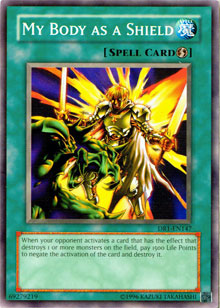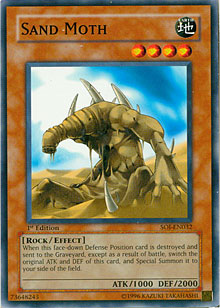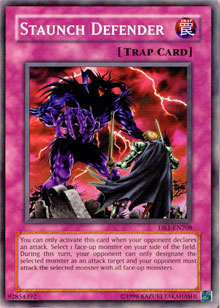Monsters: 19
1 Jinzo
1 Airknight Parshath
3 Legendary Jujitsu Master
3 Spirit Reaper
2 Exarion Universe
2 Goblin Elite Attack Force
2 Elemental Hero Wildheart
1 Breaker the Magical Warrior
1 D. D. Warrior Lady
1 Magician of Faith
1 Exiled Force
1 Sangan
Spells: 14
2 Nobleman of Crossout
2 Smashing Ground
1 Nobleman of Extermination
1 Swords of Revealing Light
1 Mystical Space Typhoon
1 My Body as a Shield
1 Premature Burial
1 Graceful Charity
1 Book of Moon
1 Snatch Steal
1 Heavy Storm
1 Confiscation
Traps: 7
3 Waboku
1 Compulsory Evacuation Device
1 Call of the Haunted
1 Torrential Tribute
1 Ceasefire
There are a number of actions you can make in the Yu-Gi-Oh! TCG. You can attack, change a monster position, activate a spell or trap, or set cards to your back row as many times as you like. However, there are a couple of actions you can usually only take once per turn. While the importance of getting a card in your draw phase is widely acknowledged, duelists rarely recognize the other once-per-turn action—performing a normal summon. I personally like to view normal summons as being incredibly important. Spend those summons wisely and you’ll dictate a game’s tempo, maintain your momentum, and usually win. Misuse them, and you might find yourself on the receiving end of a brutal beating. With Dark Hole out of the way and the format centered on aggression, duels often go to the player who managed to commit more cards to the field instead of the one who hoarded them most effectively.
Play your cards right, and the number of on-field monsters you control can become the most important factor in the game. The more you have, the more likely you are to cause damage and work toward a win. Granted, these are generalizations, and they assume that at least some of your on-field monsters are battle-worthy and capable of attacking. But if you’ve ever been pounded on by two monsters—setting one yourself every turn to save your life points while you wait to draw into an equalizer—you’ll understand what I’m talking about. Most decks can’t win without monsters on the field, and those that can still need to keep monsters out for defensive purposes.
Under this model, Legendary Jujitsu Master has the potential to be a very powerful card. It can maintain the investment you’ve made by keeping itself on the field, while at the same time costing your opponent by bouncing a monster back to the top of his or her deck. Not only does he or she lose a card, but the card that he or she loses is a monster, and that’s a far different proposition from just costing him or her an in-hand option.
 Evan’s deck is an interesting one, and you can see the reactions to his local metagame in the cards he’s selected to play. Exarion Universe punches through Spirit Reaper, turning it into a liability while also punishing Magician of Faith and other common flip effect monsters. My Body As A Shield keeps cards from destroying Legendary Jujitsu Master, Goblin Elite Attack Force counters Cyber Dragon, and Elemental Hero Wildheart breaks through Sakuretsu Armor and Bottomless Trap Hole. It’s a very sensibly constructed deck, but I’m interested in taking it in some new directions. I want to add in some different tech options that might work better than Evan’s current version, and I want to add in some more tricks for Jujitsu Master. In short, my goal is to make this deck even more difficult to play against than it already was.
Evan’s deck is an interesting one, and you can see the reactions to his local metagame in the cards he’s selected to play. Exarion Universe punches through Spirit Reaper, turning it into a liability while also punishing Magician of Faith and other common flip effect monsters. My Body As A Shield keeps cards from destroying Legendary Jujitsu Master, Goblin Elite Attack Force counters Cyber Dragon, and Elemental Hero Wildheart breaks through Sakuretsu Armor and Bottomless Trap Hole. It’s a very sensibly constructed deck, but I’m interested in taking it in some new directions. I want to add in some different tech options that might work better than Evan’s current version, and I want to add in some more tricks for Jujitsu Master. In short, my goal is to make this deck even more difficult to play against than it already was.
First, I’m going to remove the pair of Elemental Hero Wildheart and Goblin Elite Attack Force cards. Like I said, I feel like I’ve got a pretty good grasp on Evan’s goals with these cards, but I need to make some room and these are the easiest drops. While Goblin Elite is great against Cyber Dragon, it tends to get wiped out a turn later when it moves into “sitting duck” mode, and I’m not sure that the deck needs the extra Beatdown power. As for Wildheart, again, it’s a great card, but I’m going to be adding in some other monsters that can do similar tricks.
Nobleman of Extermination should probably go to the side deck. This card was at its peak when three Sakuretsu Armor cards per deck was the norm. Now that so many duelists are running single copies of each of their traps, it’s not really a great main deck choice. If duelists were still setting extra copies of Return from the Different Dimension all the time, I’d keep it, but people are a lot smarter about that kind of thing, either running just one Return or using Dust Tornado’s “set a card” effect to keep Return safe until the win is relatively certain. I’d definitely side it in against Royal Decree, though.
Finally, I’m not a huge Waboku fan, even in a deck that can use it so efficiently as this one. Three seems like overkill to me, so I’m going to remove one copy and leave the main deck with two. I’d hate to draw two copies of Waboku in the first three or four turns of a game.
I’m eager to drop Compulsory Evacuation Device for Mirror Force. I mean, it’s Mirror Force we’re talking about here. With that said, I can understand what Evan is doing. He’s using yet another card that keeps his opponent’s Chaos fodder out of the graveyard. He can recycle Magician of Faith, bounce a face-up Legendary Jujitsu Master back to his hand to reuse later at a surprising time, and he can get more mileage out of Breaker. I’m going to trust that Evan’s making the right call here, but if I were to play the deck for a few weeks, I’d test it both ways.
I’ve got six slots worth of wiggle room with which to improve the deck. Its main fear is Nobleman of Crossout: this deck hates losing an early game Jujitsu Master to Nobleman, and we’ve got to do something about that—preferably, something that can put the fear of God into any opponent who would even consider dropping Nobleman of Crossout to the table.
I’m going to open up the additions to the deck by adding two copies of Big Shield Gardna. Giving the deck more staying power in the early game (and an incredibly strong opening that is virtually impossible to disrupt) Gardna will make your opponent think twice about playing Nobleman. It will also kick out a bit of damage, and it adds a new dimension to the deck that makes it unpredictable. When you’re playing a deck that isn’t the current cookie-cutter, the element of surprise wins you games.
By the same token, a single copy of Sand Moth will fill some of the void left by Elemental Hero Wildheart. Like Wildheart, it makes the most of your own Torrential Tribute, and provides you with a backup plan for when you need to overextend. In addition, it can scare off two big threats to Legendary Jujitsu Master: Mystic Swordsman LV2, and Zaborg the Thunder Monarch. While Mystic Swordsman LV2 has seen a big decrease in play recently, Zaborg just keeps growing in popularity. A whopping fourteen copies of Zaborg were played in main decks of the Top 8 at US Nationals. For perspective, that’s just one copy less than Spirit Reaper, and while Mobius the Frost Monarch used to be a huge main-deck card, it was only played in side decks on Day 2.
 That makes Sand Moth a pretty good pick for this deck, worthy of a main deck slot and an additional copy in the side deck for matchups where the opponent is running Mystic Swordsman LV2. Be careful with it, though: try to use it when you know the opponent has a face-down monster destruction effect coming, or when you’ve loaded the field with your own Torrential Tribute.
That makes Sand Moth a pretty good pick for this deck, worthy of a main deck slot and an additional copy in the side deck for matchups where the opponent is running Mystic Swordsman LV2. Be careful with it, though: try to use it when you know the opponent has a face-down monster destruction effect coming, or when you’ve loaded the field with your own Torrential Tribute.
The final monster I want to add is a second Magician of Faith. I can’t think of a convincing reason to not use two copies of Magician of Faith, especially in a deck that’s packing Compulsory Evacuation Device. When so many games come down to who used Graceful Charity the most, it seems like a strong pick, regardless of strategy.
Moving on, I get to stick two of my all-time favorite pieces of niche tech into the deck! I’ve focused a lot on Legendary Jujitsu Master’s ability to manipulate field presence, but I’ve sort of skirted the havoc it can wreak on your opponent’s deck. Not only can it force the opponent to draw a card that is no longer optimal for the situation at hand, but if he or she doesn’t immediately play that monster back to the field, you’ve gained intelligence on the contents of his or her hand. Now granted, you only know one card in your opponent’s hand, but that’s enough for D. D. Designator to do its thing! On its own, D. D. Designator is an incredibly risky card to use that can cost you dearly for playing it poorly. But if you can read an opponent it can be an amazing piece of hand control, and it’s especially good against Chaos Sorcerer. The average duelist follows these steps when he or she draws Chaos Sorcerer:
Step 1: Draw the Sorcerer.
Step 2: Look through the graveyard.
Step 3: If graveyard contains only a Light monster, or only a Dark monster, shake head sadly and blame bad topdecking.
At this point, you know your opponent has Chaos Sorcerer in his or her hand. Blast it away with D. D. Designator, and you’ll leave it stranded outside of the duel. It’s great for when your opponent pulls a monster with Sangan, and it combos nicely with Confiscation. Add to that the combo potential with Legendary Jujitsu Master, and you’ve got a winning little piece of skill-testing tech that’s guaranteed to surprise your opponent.
 The last card I want to add is Staunch Defender. This card is so amazingly useful that it’s difficult to recap all of its potential effects in a timely manner. First, it can force a monster into a face-up Jujitsu Master. If that monster is big, you’ll lose the Master, but he or she loses his or her monster, too. If, however, the opponent controls several face-up attack position monsters and they all have 1800 ATK or less, the opponent will be forced to run all of his or her monsters into Jujitsu Master, and will lose them all.
The last card I want to add is Staunch Defender. This card is so amazingly useful that it’s difficult to recap all of its potential effects in a timely manner. First, it can force a monster into a face-up Jujitsu Master. If that monster is big, you’ll lose the Master, but he or she loses his or her monster, too. If, however, the opponent controls several face-up attack position monsters and they all have 1800 ATK or less, the opponent will be forced to run all of his or her monsters into Jujitsu Master, and will lose them all.
Beyond that, when Staunch Defender says, “During this turn, your opponent can only designate the selected monster as an attack target,” it means it. In a pinch, you can always sacrifice one monster and Staunch to block a flurry of attacks, which is decent when you’re faced with an aggressive Return player. When the monster targeted by Staunch Defender is destroyed, no more attacks will be possible that turn.
Those are all the changes I want to make to the deck, so let’s look them over in a convenient list.
–2 Elemental Hero Wildheart
–2 Goblin Elite Attack Force
–1 Nobleman of Extermination
–1 Waboku
+1 Sand Moth
+2 Big Shield Gardna
+1 Magician of Faith
+1 D. D. Designator
+1 Staunch Defender
The final version of the deck looks like this.
Legendary Jujitsu Counter Control: Jason’s Fix
40 Cards
Monsters: 19
1 Jinzo
1 Airknight Parshath
3 Legendary Jujitsu Master
3 Spirit Reaper
2 Exarion Universe
1 Breaker the Magical Warrior
1 D. D. Warrior Lady
1 Sand Moth
2 Big Shield Gardna
2 Magician of Faith
1 Exiled Force
1 Sangan
Spells: 14
2 Nobleman of Crossout
2 Smashing Ground
1 D. D. Designator
1 Swords of Revealing Light
1 Mystical Space Typhoon
1 My Body as a Shield
1 Premature Burial
1 Graceful Charity
1 Book of Moon
1 Snatch Steal
1 Heavy Storm
1 Confiscation
Traps: 7
2 Waboku
1 Call of the Haunted
1 Torrential Tribute
1 Ceasefire
1 Compulsory Evacuation Device
1 Staunch Defender
Admittedly, the deck doesn’t have the possible fast answer to Cyber Dragon anymore, but I like what it’s gained in return. With six very powerful (and completely different) set monster options, it’s going to be incredibly difficult to predict. D. D. Warrior Lady, Sangan, Big Shield, Sand Moth, Spirit Reaper, and Jujitsu Master are all very different cards, and bad reads on any one of them can tilt the odds in Evan’s favor. I’m not even counting the option of setting Exarion Universe, which is definitely strong in the right situation, given its 1900 DEF.
This deck opens really strongly, and even if it’s forced to go second, it can tie up the field and quickly mitigate the extra card the opponent got for going first. If you can, hit hard and hit early. Clear the way and then put out an early offense, because once the game becomes a matter of exchanges, you’re generally going to profit from the situation. Jujitsu Master and Gardna are awesome in simplified duels where the opponent might not ever have a pair of attackers, or Smashing Ground and an attacker to follow up. That lets you dictate the pace of the game, so don’t shy away from losing a card or two in order to move the game into topdecking at the right time.
If you can get early field advantage, then Compulsory Evacuation Device and the Sand Moth/Torrential Tribute combo become invaluable. You won’t care if you’re losing a card, because barring Mirror Force, you’ll be keeping your flow of offense coming strong. While the deck might not be equipped with a ton of raw ATK power, it can be played very aggressively, to the point that I was almost tempted to run Wall of Illusion (Wall’s effect works when it’s in attack position, while the Jujitsu Master’s does not).
At the same time it’s got a great long game, and it’s very capable of clogging up the field. Again, Jujitsu Master and this time Big Shield Gardna become important here, providing lasting defense in the mid-game where many duelists will try and stall to draw towards a win. Doing so often involves Zaborg and Nobleman of Crossout, and you’ve got answers to those threats.
It’s fair to say that good decks need to be able to quickly change gears from a passive stance to an aggressive one, and this one can do that. It can go from brick-wall defense to a very different offense pretty easily, and it exploits resource control on a more complete level than most duelists understand. With multiple answers to Chaos Sorcerer, and a core intent that hinders Return from the Different Dimension, it might be a strong candidate for competitive tournament play.
Hopefully the suggestions help Evan out. Try the deck yourself and see!
—Jason Grabher-Meyer
Do you have an Advanced format deck you could use some help with, or that you just want to show off to the world? Do you want to see it appear in a future Apotheosis article? Send it to me at Jason(at)metagame(dot)com, with your name, location, and explanation of how the deck works—I might take a crack at it!